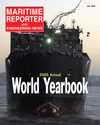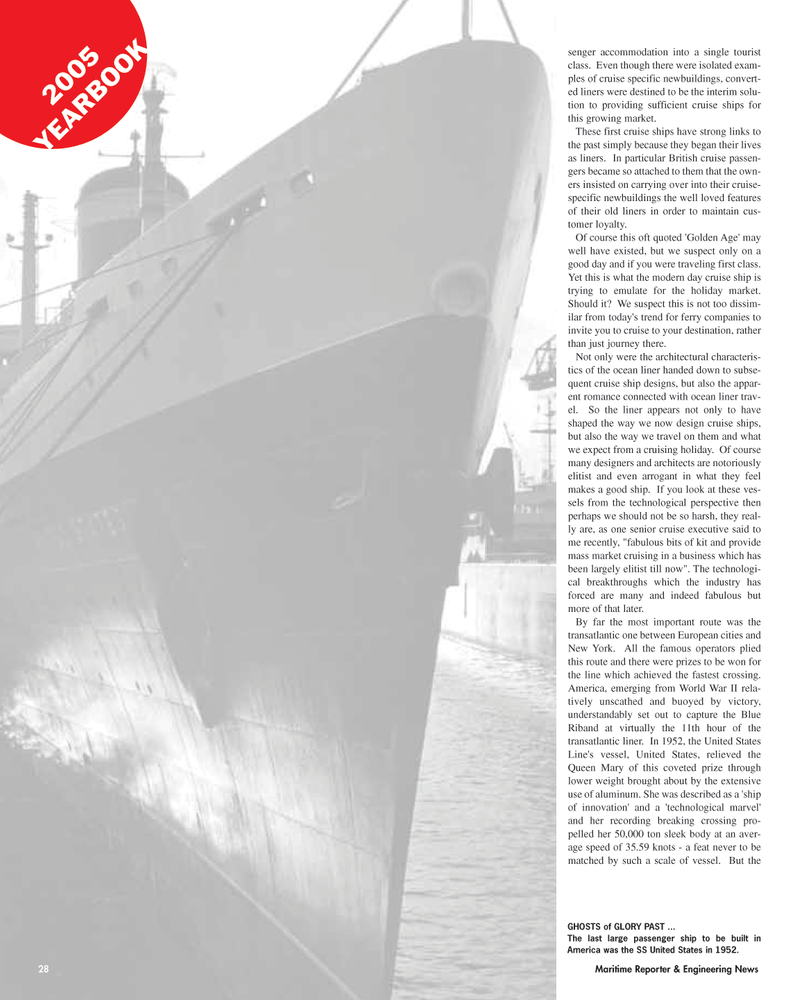
Page 28: of Maritime Reporter Magazine (June 2005)
Annual World Yearbook
Read this page in Pdf, Flash or Html5 edition of June 2005 Maritime Reporter Magazine
senger accommodation into a single tourist class. Even though there were isolated exam- ples of cruise specific newbuildings, convert- ed liners were destined to be the interim solu- tion to providing sufficient cruise ships for this growing market.
These first cruise ships have strong links to the past simply because they began their lives as liners. In particular British cruise passen- gers became so attached to them that the own- ers insisted on carrying over into their cruise- specific newbuildings the well loved features of their old liners in order to maintain cus- tomer loyalty.
Of course this oft quoted 'Golden Age' may well have existed, but we suspect only on a good day and if you were traveling first class.
Yet this is what the modern day cruise ship is trying to emulate for the holiday market.
Should it? We suspect this is not too dissim- ilar from today's trend for ferry companies to invite you to cruise to your destination, rather than just journey there.
Not only were the architectural characteris- tics of the ocean liner handed down to subse- quent cruise ship designs, but also the appar- ent romance connected with ocean liner trav- el. So the liner appears not only to have shaped the way we now design cruise ships, but also the way we travel on them and what we expect from a cruising holiday. Of course many designers and architects are notoriously elitist and even arrogant in what they feel makes a good ship. If you look at these ves- sels from the technological perspective then perhaps we should not be so harsh, they real- ly are, as one senior cruise executive said to me recently, "fabulous bits of kit and provide mass market cruising in a business which has been largely elitist till now". The technologi- cal breakthroughs which the industry has forced are many and indeed fabulous but more of that later.
By far the most important route was the transatlantic one between European cities and
New York. All the famous operators plied this route and there were prizes to be won for the line which achieved the fastest crossing.
America, emerging from World War II rela- tively unscathed and buoyed by victory, understandably set out to capture the Blue
Riband at virtually the 11th hour of the transatlantic liner. In 1952, the United States
Line's vessel, United States, relieved the
Queen Mary of this coveted prize through lower weight brought about by the extensive use of aluminum. She was described as a 'ship of innovation' and a 'technological marvel' and her recording breaking crossing pro- pelled her 50,000 ton sleek body at an aver- age speed of 35.59 knots - a feat never to be matched by such a scale of vessel. But the 28 Maritime Reporter & Engineering News 2005
YEARBOOK
GHOSTS of GLORY PAST ...
The last large passenger ship to be built in
America was the SS United States in 1952.
MR JUNE 2005 #4 (25-32).qxd 6/2/2005 7:05 PM Page 28

 27
27

 29
29
